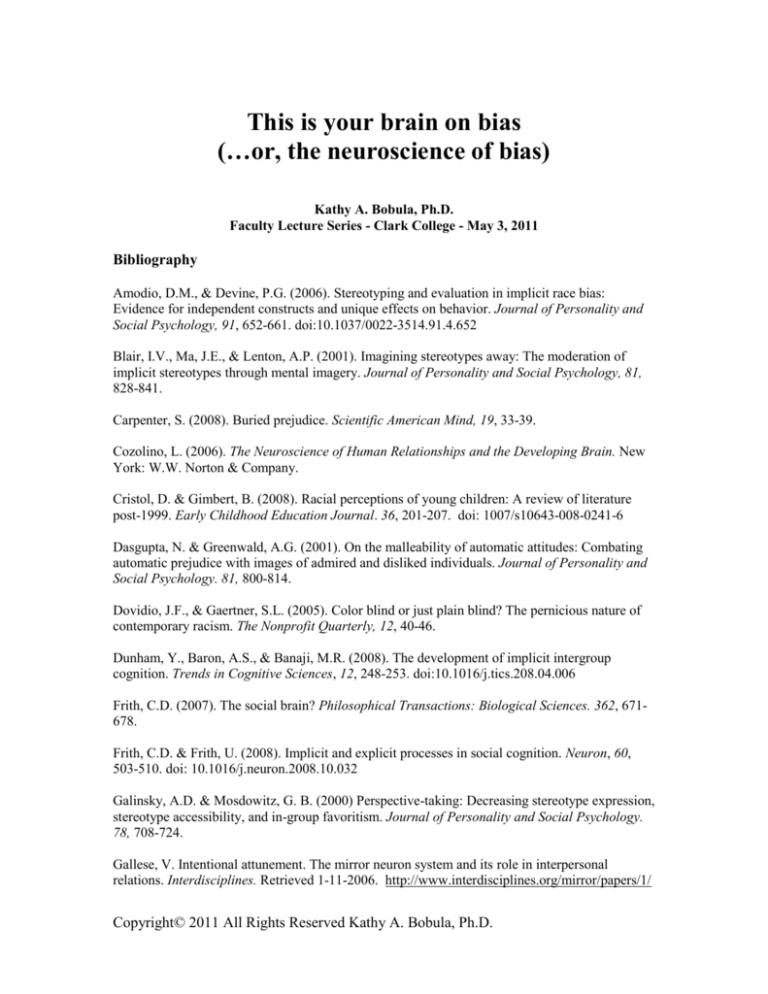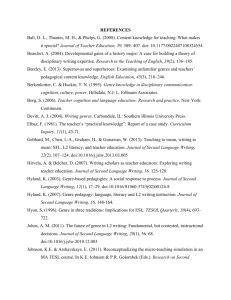
This is your brain on bias
(…or, the neuroscience of bias)
Kathy A. Bobula, Ph.D.
Faculty Lecture Series - Clark College - May 3, 2011
Bibliography
Amodio, D.M., & Devine, P.G. (2006). Stereotyping and evaluation in implicit race bias:
Evidence for independent constructs and unique effects on behavior. Journal of Personality and
Social Psychology, 91, 652-661. doi:10.1037/0022-3514.91.4.652
Blair, I.V., Ma, J.E., & Lenton, A.P. (2001). Imagining stereotypes away: The moderation of
implicit stereotypes through mental imagery. Journal of Personality and Social Psychology, 81,
828-841.
Carpenter, S. (2008). Buried prejudice. Scientific American Mind, 19, 33-39.
Cozolino, L. (2006). The Neuroscience of Human Relationships and the Developing Brain. New
York: W.W. Norton & Company.
Cristol, D. & Gimbert, B. (2008). Racial perceptions of young children: A review of literature
post-1999. Early Childhood Education Journal. 36, 201-207. doi: 1007/s10643-008-0241-6
Dasgupta, N. & Greenwald, A.G. (2001). On the malleability of automatic attitudes: Combating
automatic prejudice with images of admired and disliked individuals. Journal of Personality and
Social Psychology. 81, 800-814.
Dovidio, J.F., & Gaertner, S.L. (2005). Color blind or just plain blind? The pernicious nature of
contemporary racism. The Nonprofit Quarterly, 12, 40-46.
Dunham, Y., Baron, A.S., & Banaji, M.R. (2008). The development of implicit intergroup
cognition. Trends in Cognitive Sciences, 12, 248-253. doi:10.1016/j.tics.208.04.006
Frith, C.D. (2007). The social brain? Philosophical Transactions: Biological Sciences. 362, 671678.
Frith, C.D. & Frith, U. (2008). Implicit and explicit processes in social cognition. Neuron, 60,
503-510. doi: 10.1016/j.neuron.2008.10.032
Galinsky, A.D. & Mosdowitz, G. B. (2000) Perspective-taking: Decreasing stereotype expression,
stereotype accessibility, and in-group favoritism. Journal of Personality and Social Psychology.
78, 708-724.
Gallese, V. Intentional attunement. The mirror neuron system and its role in interpersonal
relations. Interdisciplines. Retrieved 1-11-2006. http://www.interdisciplines.org/mirror/papers/1/
Copyright© 2011 All Rights Reserved Kathy A. Bobula, Ph.D.
Gallese, V., Migone, P., & Eagle, M. (submitted to JAPA). Intentional attunement: Mirror
neurons and the neural underpinnings of interpersonal relations. Retrieved 1-1-2011:
http://www.mimetictheory.org/bios/gallese.html
Greenwald, A.G. & Krieger, L.H. (2006). Implicit bias: Scientific foundations. California Law
Review. 94, 945-967.
Guinote, A., Willis, G.B., & Martellotta, C. (2010). Social power increases implicit prejudice.
Journal of Experimental Social Psychology. 46, 299-307. doi: 10.1016/j.jesp.2009.11.012
Gutsell, J.N. & Inzlicht, M. (2010). Empathy constrained: Prejudice predicts reduced mental
simulation of actions during observation of outgroups. Journal of Experimental Social
Psychology. 46, 841-845. doi:10.1016/j.jesp.2010.03.011
Heyes, C. (2010). Where do mirror neurons come from? Neuroscience and Biobehavioral
Reviews, 34, 575-583. doi: 10.1016/j.neubiorev.2009.11.007
Iacoboni, M., Molnar-Szakacs, I., Gallese, V., Buccino, G., Mazziotta, J.C., & Rizzolatti, G.
(2005). Grasping the intentions of others with one’s own mirror neuron system. PLoS Biology, 3,
(3): e79.
Knowles, E.D., Lowery, B.S., & Shaumberg, R.L. (2010). Racial prejudice predicts opposition to
Obama and his health care reform plan. Journal of Experimental Social Psychology. 46, 420-423.
doi: 10.1016./j.jesp.2009.10.011
Leander, N.P., Chartrand, T.L., & Wood, W. (2011). Mind your mannerisms: Behavioral mimicry
elicits sterotype conformity. Journal of Experimental Social Psychology. 47, 195-201.
doi: 10.1016/j.jesp.2010.09.002
Lebrecht, S., Pierce, L.J., Tarr, M.J., & Tanaka, J.W. (2009). Perceptual other-race training
reduces implicit racial bias. PLoS ONE, 4, 1-7.
Lev-Ari, S. & Keysar, B. (2010). Why don’t we believe non-native speakers? The influence of
accent on credibility. Journal of Experimental Social Psychology. 46, 1093-1096.
doi:10.1016/j.jesp.2010.05.025
Livingston, R.W., & Drwecki, B.B. (2007). Why are some individuals not racially biased?
Susceptibility to affective conditioning predicts non prejudice toward blacks. Psychological
Science, 18, 816-823.
Maroney, T.A. (2009). Unlearning fear of out-group others. Law and Contemporary Problems.
72, 83-88.
McGillicuddy-De Lisi, A.V., Daly, M., Neal, A. (2006). Children’s distributive justice
judgments: Aversive racism in Euro-American children. Child Development. 77, 1063-1080.
Meltzoff, A.N. (1995). Understanding the intentions of others: Re-enactment of intended acts by
18-month-old children. Developmental Psychology.34, 838-850.
Copyright© 2011 All Rights Reserved Kathy A. Bobula, Ph.D.
Meltzoff, A.N. (2007). ‘Like me’: A foundation for social cognition. Developmental Science, 10,
126-134. doi: 10.1111/j.1467-7687,2007.00574.x
Meltzoff, A.N. & Decety, J. (2003). What imitation tells us about social cognition: A
rapprochement between developmental psychology and cognitive neuroscience. Philosophical
Transactions of the Royal Society B:Biological Sciences. 358, 491-500.
Meltzoff, A.N. & Moore, M.K. (1977). Imitation of facial and manual gestures by human
neonates. Science. 198, 75-78.
Méndez Barletta, L. (2008). Teachers’differential treatment of culturally and linguistically
diverse students during sharing time. Colorado Research in Linguistics. 21, 1-21.
Molnar-Szakacs, I., Wu, A.D., Robles, F.J., Iacoboni, M. (2007). Do you see what I mean?
Corticospinal excitability during observation of culture-specific gestures. PLos ONE. 2 (7): e626.
doi: 10.1371/journal.pone.0000626.
Retrieved 12-17-2010. http://www.plosone.org/article/info
Morrison, K.R. & Chung, A.H. (2011). “White” or “European American”? Self-identifying labels
influence majority group members’ interethnic attitudes. Journal of Experimental Social
Psychology. 47, 165-170. doi: 10.1016/j.jesp.2010.07.019
Navarrete, C.D., Olsson, A., Ho, A.K., Mendes, W.B., Thomsen, L., & Sidanius, J. (2009). Fear
extinction to an out-group face: The role of target gender. Psychological Science. 20, 155-158.
Öhman, A. (2005). Conditioned fear of a face: A prelude to ethnic enmity? Science. 309, 711713. doi:10.1126/science.1116710
Olson, M.A. & Fazio, R.H. (2001). Implicit attitude formation through classical conditioning.
Psychological Science. 12, 413-417.
Olson, M.A., & Fazio, R.H. (2006). Reducing automatically activated racial prejudice through
implicit evaluative conditioning. Personality and Social Psychology Bulletin, 32, 421-433.
doi:10.1177/0146167205284004
Olsson, A., Ebert, J.P., Banaji, M.R., & Phelps, E.A. (2005). The role of social groups in the
persistence of learned fear. Science. 309, 785-787. doi:10.1126/science.1113551
Olsson, A. & Phelps, E.A. (2004). Learned fear of “unseen” faces after Pavlovian, observational,
and instructed fear. Psychological Science. 15, 822-828.
Pearson, A.R., Dovidio, J.F., & Gaertner, S.L. (2009). The nature of contemporary prejudice:
Insights from aversive racism. Social and Personality Psychology Compass, 3, 1-25.
doi:10.111/j.1751-9004.2009.00183x
Phelps, E.A. (2006). Emotion, learning, and the brain: From classical conditioning to cultural
bias. In P.B. Baltes, P.A. Reuter-Lorenz, & F. Rösler, (Eds.), Lifespan development and the
brain: The perspective of biocultural co-constructivism (pp.200-216). New York: Cambridge
University Press.
Copyright© 2011 All Rights Reserved Kathy A. Bobula, Ph.D.
Phelps, E.A., O’Connor, K.J., Cunningham, W.A., Funayama, E.S., Gatenby, J.C., Gore, J.C., &
Banaji, M.R. (2000). Performance on indirect measures of race evaluation predicts amygdala
activation. Journal of Cognitive Neuroscience. 12, 729-738. doi:10.1162/089892900562552
Phelps, E.A. & Thomas, L.A. (2003). Race, behavior, and the brain: The role of neuroimaging in
understanding complex social behaviors. Political Psychology. 24, 747-758.
Rudman, L.A. (2004). Sources of implicit attitudes. Current Directions in Psychological Science.
13, 79-82.
Rudman, L.A., Ashmore, R.D., & Gary, M.L. (2001). “Unlearning” automatic biases: The
malleability of implicit prejudice and stereotypes. Journal of Personality and Social Psychology.
81, 856-868.
Rudman, L.A., Greenwald, A.G., & McGhee, D.E. (2001). Implicit self-concept and evaluative
implicit gender stereotypes: Self and ingroup share desirable traits. Personality and Social
Psychology Bulletin. 27, 1164-1178. Doi:10.1177/0146167201279009
Sinclair, S., Dunn, E., & Lowery, B.S. (2004). The relationship between parental racial attitudes
and children’s implicit prejudice. Journal of Experimental Social Psychology. 41, 283-289.
doi:10.1016/j.jesp.2004.06.003
Squire, L.R., & Kandel, E.R. (2009). Memory: From Mind to Molecules. Greenwood Village,
CO: Roberts & Company.
Stewart, B.D. & Payne, B.K. (2008). Bringing automatic stereotyping under control:
Implementation intentions as efficient means of thought control. Personality and Social
Psychology Bulletin. 34, 1332-1345.
Wheeler, M.E. & Fiske, S.T. (2005). Controlling racial prejudice: Social-cognitive goals affect
amygdala and stereotype activation. Psychological Science. 16, 56-63.
To take an implicit bias test, go to: Project Implicit. https://implicit.harvard.edu/implicit/
Developing Brains
Ideas for Parenting and Education from the New Brain Science
www.developingbrains.org
Copyright© 2011 All Rights Reserved Kathy A. Bobula, Ph.D.
What we can do
First, accept the fact that each of us learned biased beliefs, assumptions,
and stereotypes about people who are members of “out-groups”. We can
challenge these by focusing our attention on members of that out-group who
do not fit these conceptions. Purposefully look for counterstereotype
examples. Do this a lot.
Second, when encountering a person who is different from you, check how
you are feeling and try to get a hint of what you might be thinking about this
person and how it makes you feel. This awareness will help you find out what
specific stereotypes you hold.
Third, remember that we all have unconscious, implicit biases about others.
Find a word or phrase that counters the stereotype you have and say this
word to yourself whenever you encounter a member of that group.
Fourth, remember also that we are born with a neural bias for in-group
members. Factor this in when making decisions, such as in hiring or
evaluating people who are members of an out-group.
Fifth, know that experiences impact both our conscious and unconscious
thoughts and what we remember. Intentionally get to know people who are
not like you. Get to know them well.
Sixth, mirror neurons allow us to feel how others feel. When interacting
with people who are different than you, practice increasing your
understanding of them and your empathy for them.
Seventh, purposefully work to reflect on and transform your behavior
toward out-group members in such a way that you reduce the impact of your
stereotypes and biases on your actions and interactions.
Copyright© 2011 All Rights Reserved Kathy A. Bobula, Ph.D.



